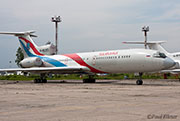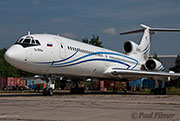13 July 2009
The final chapter of our adventure would be back in Moscow so we had yet another early morning flight this time from Tomsk to Domodedovo on an S7 A319 instead of a Tu-154 that only a few years ago would be normal on this leg.
Walking through the busy terminal building slammed home that we had really been out where few people tend to travel. All our transits through the outlying airports had been quick, un-crowded and trouble free, apart for some of the strange paperwork exercises to get to the aircraft in some locations. This was a modern busy and efficient terminal with no remnants of the old Soviet era architecture, which in a lot of ways is a shame.
We were greeted by another minibus, which would take us to our final destination of Vnukovo airport. At the beginning of the entrance road on the junction of the motorway is a beautifully preserved Tu-104. This is the second Tu-104 that has been displayed at this airfield; the first was outside the terminal but was broken up in 2004. This aircraft CCCP-42507 is marked as CCCP-L5412 as was placed here in 2008 after languishing at the Tupolev rework facility for many years. It's amazing what can be done with a good clean and a fresh coat of paint.
Vnukovo is the closest airport to Moscow's city centre being only 27 kilometres away but it wasn't the normal passenger side of the airport that we would be visiting but the much more interesting rework facility next to the business jet centre on the other side of the airfield. The Vnukovo International Maintenance Repair and Overhaul Center, or VARZ-400 as it is commonly known, has been around since 1941 and was involved with the maintenance and repair of Li-2 and C-47 aircraft and their engines. They went on to work with Il-12s before moving to the jet age with the Tu-104s. They are currently the largest facility of this type in Russia being able to work on airframe, engine, avionics, reworks, upgrades and painting as well as aircraft leasing - basically a one stop shop.
Nowadays they seem to specialize in Tu-154, Yak-40 and Yak-42 bringing these classics back to a factory fresh condition. We saw both ends of this work with a Bulgarian Tu-154 sitting without wings and looking a little sorry through to an absolutely immaculate Tu-154 ready for delivery, so we were told, to the Federal Security Service. The Tu-154 was the most numerous of the aircraft we saw there. The company has recently been given certificates to work on Boeing 737 and Airbus A319/A320 family of aircraft mirroring the change in the Russian aviation market. We didn't see any evidence of the western types however.
Our guide here was well known to Steve and we were warned that he would be either in a bad mood, or if we were unlucky, a terrible mood. After the formalities of getting through the gates our guide walked out of a building towards us smiling and greeting Steve and Olga like old friends. This put Steve on his back foot because, as he mentioned later, he had never even seen him smile before. His favourite way to get our attention was to blow hard on a whistle. Our aim was to stop him using it and therefore be on his better side.
We were driven around and allowed to wander the huge ramp area at this facility until we came to the main ramp with two lines comprising mostly of Tu-154s. At the end of the line was a pair of Il-86VKP/Il-87 command control aircraft. We were told in no uncertain terms that we couldn't take photos of these aircraft. They had a sideways looking radar array on the top of the fuselage and some very interesting pods between the inboard engine and fuselage. Luckily everyone behaved and complied as we would have been shown the door immediately as we were being watched like hawks. The fact that we would have been shooting right into the sun certainly stopped any sneaky photos anyway.
With all the ramps being covered we were asked if we wanted to shoot over the fence at the business jets in the adjoining area of the airfiled. Once again Steve's jaw dropped to the ground as they had always been denied that request on numerous prior trips, and here he was actually offering! After only three or four minutes we were whistled back to the bus, but sometimes a short opportunity is better than none.
With that done the only aircraft left to shoot was the Tu-204C-100, which is the cargo derivative of the Tu-204 airliner. Although it can carry up to 30 tones it seems like this modification never really took hold and so this demonstrator sits forlornly in the corner of the facility.
So with this part of the tour over we went back to Domodedovo to catch our flight back home. Steve and myself flew back on an old Boeing 737-300 operated by Transaero while the rest of the group got later flights back. This type of trip was one that I've wanted to do for a long time and it took me a while to find the correct itinerary and group leader. Russia is a difficult place to explore independently and for anything outside of Moscow it is certainly advisable to at least have an interpreter. The Russian Embassy wants to know exactly which hotel you are staying in each day even before they will even issue a visa with exact entry and exit dates.
All the people we met were gracious and hospitable, especially in Siberia where foreigners are not often seen and it was a privilege to have been able to peek a little into the aviation side of this huge country. My personal highlights were the An-24 flight and the grass roots airfields we visited where we were welcomed with open arms and smiles. Spasibo bolshoe!
4 June 2010
We had an appointment across the airfield at the VARZ-400 rework facility. We saw a couple of Tu-154s that used to fly with Samara Airlines, one of which is the ex VIP aircraft for the Samara region of Russia which includes the regions coat of arms on the tail. This airline ceased operations in 2008.
Two airlines that seem to be doing well are Gazpromavia who had a bunch of Yak-42s here in the new colours looking like they had been freshly overhauled, and Alrosa who had a couple of nice looking Tu-154s on the ramp. Tu-154 RA-85790 painted in the Yakutiya scheme is an aircraft that was a regular in Europe in the late nineties, as it flew with Balkan as LZ-LTC.
One long term addition to the facility was Il-86 RA-86123 of Atlant-Soyuz which will most probably never fly again as it is engineless and being robbed for spares. So the day was nearly done and we had a great fill of Russian types that will be hard to beat as time marches on.
Next stop Domodedovo.
Subscribe to receive updates via: e-mail list | Facebook | Instragram | Twitter
[photo/serial list]

